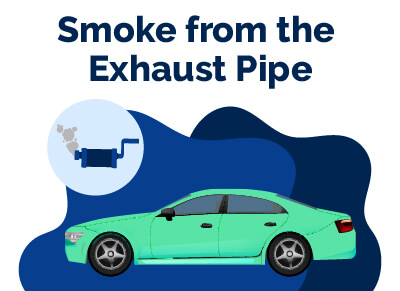White, Blue, or Black Smoke From Exhaust/Tailpipe
August 9, 2023


Chris is Head of Content for FindTheBestCarPrice and is based out of Philadelphia, PA. As a seasoned automotive industry analyst and car enthusiast, he ensures the highest level of quality across all our content and curates our picks for the best deals each month.
Chris studied information systems and marketing at Drexel University and writes about a wide range of topics ranging from car buying tips to troubleshooting common mechanical issues.
When he’s not thinking about cars, he likes to stay in with his dog and make an “attempt” to finish a crossword puzzle (he’s not quite at the Saturday/Sunday level…yet). As a former cheesemonger, Chris still has a “sharp” passion for all things cheese, and his fridge is always loaded with it!
Chris also has a passion for things that go fast, and drones are no exception. He spends some of his time writing for Dronesourced.
Exhaust emissions are an inevitable byproduct of vehicles powered by internal combustion engines, and as long as the emissions are of the appropriate hue and inconspicuous, they are deemed acceptable.
Ideally, a properly functioning engine should emit no discernible smoke from the exhaust pipe.
However, if smoke is detected, it likely indicates an underlying issue within the engine. Specifically, the presence of white, blue, or black smoke from the exhaust pipe would reasonably suggest that a malfunction or fault has occurred.
Let’s discuss the various causes of white, blue, or black smoke from exhaust or tailpipe.
Table of Contents
Diagnosing White, Blue, or Black Smoke From Exhaust or Tailpipe
The initial step entails discerning the precise circumstances under which the smoke emanates from your vehicle's exhaust.
If it only emerges during acceleration, it may indicate a specific issue compared to when it only appears when the vehicle is stationary or persists consistently while the engine is in operation.
Once you have determined when the smoke occurs, the subsequent task is to ascertain its characteristics.
Is it white, grey, or tinged with a hint of blue? Alternatively, is it dense and black? Does it dissipate rapidly upon dispersal in the air, or does it linger with a pungent odor? In the case of black smoke, does it leave soot residue on the road beneath the exhaust tip when the vehicle is stationary?
The underlying causes of exhaust smoke can vary depending on the make and condition of your vehicle.
If your car is well-maintained and regularly serviced, visible emissions from the exhaust are unlikely to raise concern, although it is prudent to conduct a thorough check nonetheless.
The crux of the issue lies with inadequately maintained vehicles, as smoke from the exhaust can indicate neglect.
This can be a valuable clue when purchasing a used car, as a smoking exhaust and incomplete service history can indicate underlying problems.
The smoke observed can be attributed to different factors, depending on whether your vehicle is equipped with a petrol or diesel engine.
Even hybrid vehicles may exhibit spontaneous emissions from the exhaust, warranting due diligence on the owner's part.
If Black Smoke Comes Out of the Exhaust or Tailpipe
Although counterintuitive, black exhaust smoke, particularly in diesel vehicles, may be of lesser concern. However, it should be rare, and persistent black smoke could indicate a fault or worn-out engine.
Black smoke is often a sign of excessive fuel being burnt in relation to the air intake, commonly referred to as running rich.
This could be caused by a clogged air filter, malfunctioning fuel injectors, or an issue with the fuel pressure regulator, resulting in an over-fueling condition.
In turbocharged vehicles, black smoke is more likely due to the turbocharger acting as a pump, forcing more air into the engine.
The car's computer system calculates the appropriate amount of fuel to match the increased air intake.
However, if the turbocharger is damaged or there is a 'boost leak' from a pipe, causing air to escape before combustion, it can lead to over-fueling and black exhaust smoke.
In diesel vehicles, black smoke could indicate soot buildup, a byproduct of diesel combustion, or a clogged diesel particulate filter (DPF) within the exhaust system.
Occasionally, a longer drive at higher speeds on a motorway can allow the DPF to self-clean, resulting in a puff of black smoke.
However, if the filter becomes persistently blocked or broken, a warning light on the dashboard and a noticeable loss of power may occur.
Suppose black exhaust smoke becomes frequent or constant, whether in a petrol or diesel vehicle; it is crucial to seek urgent repairs.
Continued operation in this state can result in increased fuel consumption, potential damage to sensors and exhaust components, and costly repairs, including the catalytic converter in petrol engines.
When White Smoke Comes Out of the Exhaust
When observing a white cloud emanating from your exhaust, it is crucial to discern whether it is smoke or steam, as the latter is typical in small quantities.
During periods of colder weather, moisture can accumulate in the exhaust of a parked vehicle, leading to significant white clouds upon start-up.
However, this phenomenon will gradually dissipate as the engine and exhaust reach their optimal operating temperature.
If your vehicle is fully warmed up and continues to emit white smoke from the exhaust, it may indicate a fault. Persistent thick white smoke is often a telltale sign of coolant being burned, which is a cause for concern.
The typical culprit for this issue is a faulty head gasket. The head gasket is a thin, shaped metal sheet positioned between the cylinder head and block, creating a seal between the two components and preventing coolant leakage from the engine's surrounding jacket.
If the head gasket fails, coolant may escape from the water jacket or cooling channels and enter the cylinder, where it will be burned.
As the severity of the gasket failure increases, more coolant will enter the cylinder, resulting in a sudden increase in steam from the exhaust at high pressure.
In such cases, shutting off the engine promptly is imperative to prevent further damage.
Excessive coolant in areas where it is not intended to be can cause severe and irreversible internal engine damage. Furthermore, if the engine runs out of coolant, it can overheat and exacerbate the damage.
Hence, it is crucial to regularly check the coolant level in your engine, just as diligently as monitoring the engine oil level, to ensure your vehicle's proper functioning and longevity.
If Blue Smoke Comes Out of the Exhaust
Blue exhaust smoke, exhibiting varying shades depending on its thickness, indicates that engine oil is being incinerated.
It is common for engines to consume a minute amount of oil, which is why the oil level in the engine naturally diminishes and changes color.
Nevertheless, the amount of oil burned in a healthy engine should not be sufficient to generate visible smoke.
A repair is likely warranted if you notice blue smoke or detect its distinct odor. The severity of the issue may differ, and the repair cost may not necessarily be exorbitant.
However, as with any automotive repair, addressing the problem sooner rather than later can mitigate costs.
The initial step in investigating the cause of the burning oil is to identify its source. One common culprit is the turbocharger if your vehicle is equipped with one.
An oil feed lubricates the components of a turbocharger to reduce friction and maintain efficiency.
If this oil feed develops a leak and the oil mixes with the air being pumped into the engine, it can enter the cylinders and be burned.
The repair may be relatively inexpensive if the issue lies with the oil feed itself. However, if the turbocharger unit is faulty, it may require costly rebuilding or replacement.
In older or higher-mileage vehicles, smoke emissions can be attributed to natural wear and tear over time. The cylinder walls, pistons, and valves can all gradually deteriorate, allowing oil to seep into areas where it should not.
Once this process commences, the engine may require repair, rebuilding, or replacement. It is also plausible for oil ingress into the cylinders to be an indication of head gasket failure.
Best Car Deals by Category
Frequently Asked Questions
Why is white smoke coming from my exhaust/tailpipe?
A few different factors can cause white smoke from the exhaust. It could indicate condensation in the exhaust system, especially during colder weather, which is usually harmless. However, it could also be a sign of a blown head gasket, requiring immediate attention as it can damage the engine. Another possible cause is the burning of coolant due to a leak in the cooling system.
What does blue smoke from my exhaust/tailpipe mean?
Blue smoke from the exhaust often indicates that engine oil is being burned. This could be due to worn piston rings, valve seals, or other internal engine issues that allow oil to enter the combustion chamber. A malfunctioning turbocharger can also cause blue smoke if your vehicle has one. Addressing blue smoke promptly is essential, as it can lead to decreased engine performance and increased emissions.
Why is black smoke coming from my exhaust/tailpipe?
Black smoke from the exhaust is usually a sign of an overly rich fuel-to-air mixture. This means the engine is burning more fuel than it should, resulting in incomplete combustion and soot particles. Common causes of black smoke include a faulty fuel injector, a malfunctioning mass air flow sensor, or an issue with the fuel pressure regulator. Addressing the underlying cause of the rich fuel mixture is crucial to prevent further engine damage and reduce emissions.
Can a hybrid vehicle produce exhaust smoke?
Yes. Even hybrid vehicles can produce exhaust smoke under certain circumstances. For instance, during cold starts or when the hybrid system is in regenerative braking mode, the engine may run to charge the battery, which can result in visible exhaust emissions. However, if you notice persistent or unusual smoke from your hybrid vehicle's exhaust, it may indicate a malfunction in the hybrid system or other components that require attention.
Posted in Car Buying Tips, Car Troubleshooting |




